Common Errors to Steer Clear of When Painting Your Front Door
Your house's front door isn't just an entryway; it's an initial glimpse into your abode for visitors. It holds significance as one of the first aspects people observe about your home, and as we know, the initial impression matters. Applying a fresh coat of paint to your front door can be a satisfying task. A finely painted entryway reflects your penchant for quality and indicates your commitment to creating a welcoming and appealing home environment.
Revamping your front door with a paintbrush and a can of paint can breathe new life into its appearance, but the task demands attention to detail. Several mistakes can turn what should be an enjoyable project into one you might regret. It's not just a matter of randomly selecting a color, applying it, and admiring the outcome. Hence, it's crucial to familiarize yourself with common errors and their prevention before you commence this undertaking.
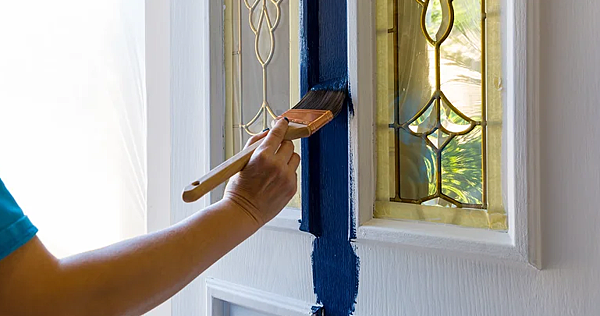
Choosing a color that's not right for your surroundings
In a world devoid of diverse colors and shades, the ambiance would lack vibrancy and appeal. Similar to nature, the realm of design hinges on the power of color selection. Just as we meticulously pick the right paint hue that harmonizes with a room's decor, equal attention should be paid to the color of our front door in relation to its environment. A useful guideline is selecting a dark-colored door for a light-toned house exterior and vice versa for a darker façade. This approach fosters equilibrium and contrast within your design scheme, preventing visual disarray.
Exterior accents offer valuable cues too. Consider the color of your garage door or shutters, if present. You can choose to align with these hues, opt for shades within the same color family, or even select an entirely different color. The crucial element is ensuring that all the colors on your house's exterior complement each other, crafting a refined and inviting aesthetic.

Choosing white as the color for your residence in a bustling neighborhood
Choosing white as the color for your front door might seem like a secure choice due to its ability to reflect the entire light spectrum. White doors offer numerous advantages, creating a serene atmosphere, an impression of spaciousness, and a warm welcome for visitors. However, living in a bustling area may pose challenges for white doors. While they harmonize with many color schemes and possess a timeless quality, they are notoriously difficult to maintain, particularly in neighborhoods with high traffic.
If your front entrance sees a lot of activity, a white front door may become burdensome due to the constant accumulation of dirt and grime from passing traffic. This upkeep will require frequent cleaning and touch-ups, potentially leading you to question your initial decor decision. Furthermore, research indicates that painting your front door black can enhance your home's curb appeal and value.

Choosing a color that is currently popular rather than opting for a timeless choice
Many individuals tend to prioritize current trends over functionality, choosing what's fashionable rather than timeless. While it's fine if you intend to frequently repaint your front door, it's a considerable error if you prefer a 'paint it once and forget it' approach. Despite their current popularity, there are specific colors that experts universally recommend avoiding when painting your front door.
Andre Kazimierski, CEO of Improovy Painters Denver, shared with Livingetc, "You can experiment with bold colors that align with your home's style and exterior paint job, but overly bright shades like hot pink may prove challenging to match with your home's overall look."
For those enthusiastic about a Barbie-inspired front door, consider softer hues like pastel or dusky pink to exude a more refined appearance. Vibrant colors such as orange have the potential to give your house an overly vivid appearance. Interior designer Allison Garrison highlights to Livingetc, "A vivid orange door might seem stark and unwelcoming. Opting for a softer coral or a subdued terracotta can create a more inviting atmosphere."
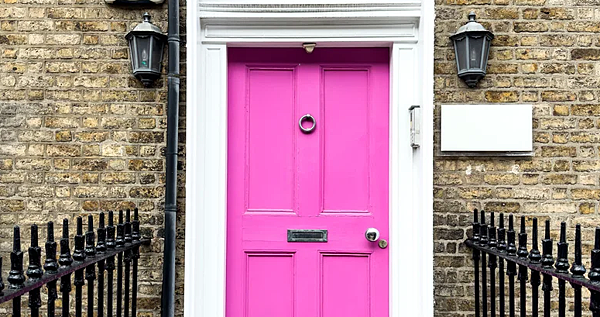
Not wearing the appropriate safety equipment
Once you've chosen the color for your front door, bought the paint, set aside time for the task, and are all set to begin, it's important to remember one crucial aspect before diving into the painting process—ensuring you have the proper safety gear. Any DIY endeavor, whether it's installing a shelf or painting a front door, carries risks if safety measures are overlooked.
Before commencing the painting process, inspect your front door for rust, algae, mold, or moss that should be addressed prior to painting. Most of these issues can be tackled using standard cleaning solutions, but exercise caution, especially when dealing with mold; it's advisable to wear a protective mask and gloves. Similarly, when sanding the front door, wear safety goggles and take necessary precautions. As you start painting, it's essential to protect your hands and avoid exposure to potentially harmful paint fumes, so ensure you wear gloves and a mask.
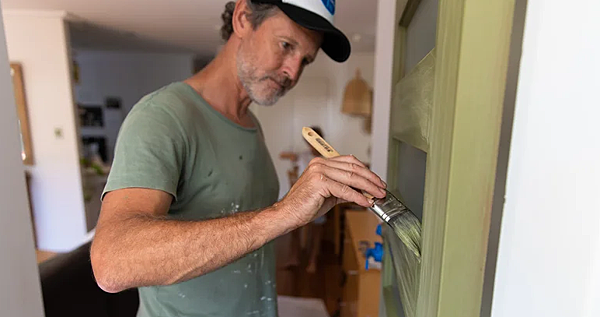
Failing to eliminate any noticeable bumps or imperfections before starting the painting process
It's often tempting to hasten the front door painting process, aiming to achieve the desired results quickly. When inspired by a vision of the door's potential, there's a tendency to opt for shortcuts. In the rush to save time, one might overlook the need to smooth out any visible bumps or imperfections present on the surface before commencing the job. This approach is highly discouraged! Inadequate preparation stands as the primary reason for potential setbacks when painting your front door.
Even if the door appears to be in good shape, it requires sanding to ensure proper priming and painting. Generally, gentle sanding along the wood grain suffices. However, for doors with peeling paint, noticeable bumps, or numerous scratches, a more thorough sanding approach is necessary. Attempting to rush through this process may lead to repercussions later on.
Utilize a scraper or putty knife to eliminate larger paint chips. Employ a palm sander to address other imperfections and blemishes. Starting with a low grit sandpaper and gradually progressing to medium and high grits is advisable. Finally, use a tack cloth to wipe away any lingering dust particles to preserve the integrity of your paint application.

Choosing to forgo the use of a primer
Once you've finished sanding your front door and it appears sleek, refined, and ready for a fresh coat of paint, there might be a temptation to swiftly dive into painting. However, it's crucial to apply a coat of primer before proceeding with the painting process. Not using a primer is a common and easily avoidable mistake. While some paints claim to eliminate the need for a primer, taking the extra step is a prudent choice for the appearance of your front door, especially when painting over a sanded door or one with a deep, intense hue.
Primers play a crucial role in ensuring that the paint adheres smoothly and uniformly to the front door surface. This foundational layer assists in enhancing the durability of your paint job, offering resilience against various weather conditions. You may opt for a primer that closely matches the final paint color, but white primer is effective in preventing the original paintwork from showing through. Prior to applying the primer, in addition to sanding, make sure any visible holes or cracks have been thoroughly filled.
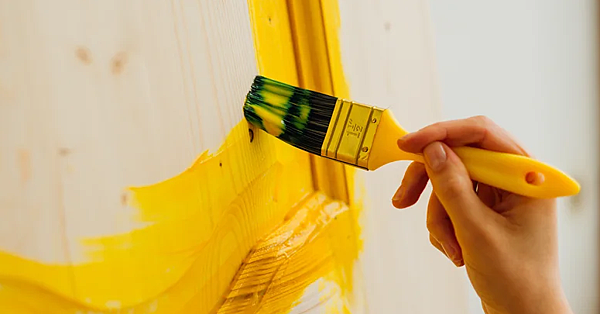
Neglecting to shield or protect existing hardware with tape is a common mistake during painting
When painting your front door, few mishaps are as bothersome as accidentally splashing paint on existing hardware. The music's playing, you're painting away, and suddenly, disaster strikes! Paint splatters on the handle, letterbox, door knockers, bells, and glass panels. Yet, this could all be easily avoided by covering the existing hardware with tape before commencing the project.
Using masking or painter's tape is a lifesaver, especially for front door painting. It's crucial to tape not just the obvious parts like the door handles or letterboxes, but also internal areas like the locking mechanism to prevent paint from seeping in and causing issues. Alternatively, for an extra cautious approach, consider removing the hardware before painting. This allows for thorough cleaning and even the opportunity to give it a fresh appearance with a coat of complementary metal paint to match your newly painted front door.

Selecting an incorrect type of paint can lead to issues when painting
You'd be surprised by how many individuals mistakenly choose the incorrect paint type for their front doors. Despite seeming like a beginner's error, the wide variety of paint types and shades available makes it an easy mistake. The fundamental rule is to keep any interior-specific paint far away from your front door, even if the label suggests it's suitable for woodwork.
Choosing the appropriate finish is equally important. A flat or low-sheen finish can be difficult to clean, while excessive glossiness will accentuate every flaw. Opting for a semi-gloss exterior paint serves as a versatile option, capable of enduring daily wear, weather conditions, and potential impacts. Consumer Reports paint testing engineer Richard Handel noted, "Semi-gloss finishes are typically easy to clean, ensuring they maintain a good appearance for years."

Believing that a single coat of paint will suffice
Another common mistake when painting a front door is assuming that a single coat will suffice. Even with a well-maintained door, applying at least two coats is necessary to ensure the color remains vibrant. A worn-out and lackluster appearance sends the wrong message and doesn't enhance the entryway's appeal.
If you're working with bare wood, two coats may not suffice to completely cover the grain. It's particularly frustrating when the old color resurfaces due to insufficient paint coverage. For a durable and robust finish, applying three coats is advisable. Opt for a dry day without rain for optimal results. If possible, align your painting schedule with the weather forecast, start early, and always follow the paint can instructions for drying times.
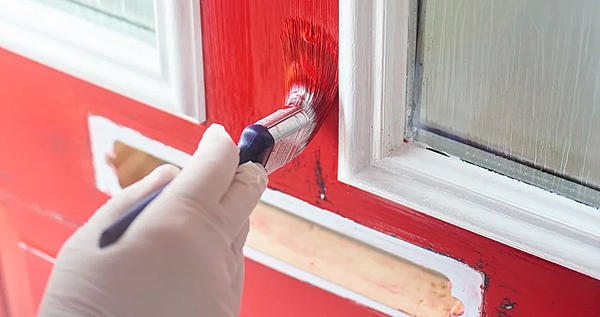


 留言列表
留言列表


